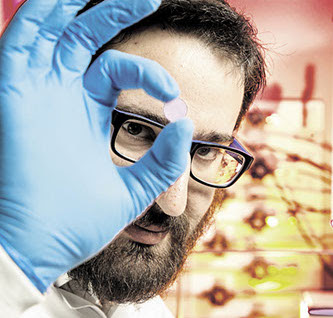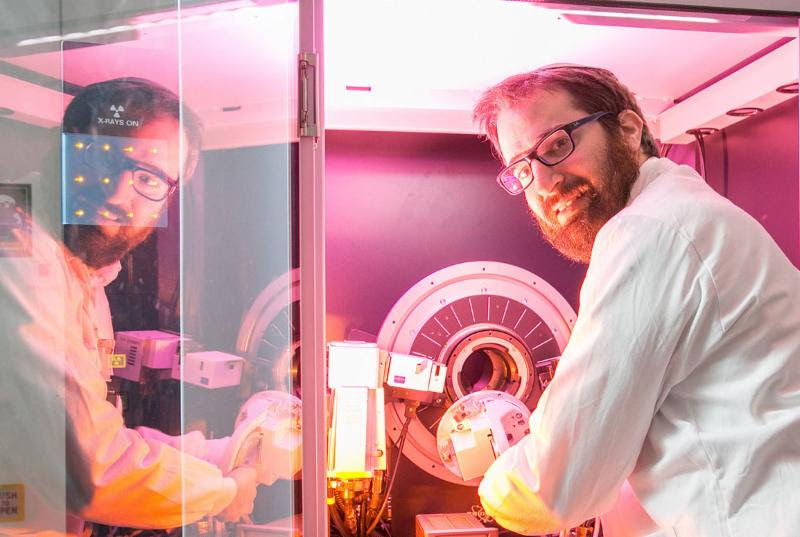Interview by Hani Lowenstein, Associate Director of Community Projects, OU-JLIC:
 Dr. Brian Rosen is an assistant professor in the Department of Materials Science and Engineering at Tel Aviv University and is the founder of the department’s Energy Materials Laboratory. Last year, Brian was named by the Calcalist and the The Marker as one of Israel’s 40-under-40. While completing an M.S. and Ph.D. at the University of Illinois at Urbana-Champaign (UIUC), Brian became an active member of the OU-JLIC community on campus and eventually met his wife, Shiri, there as well, the sister of the OU-JLIC female Torah educator.
Dr. Brian Rosen is an assistant professor in the Department of Materials Science and Engineering at Tel Aviv University and is the founder of the department’s Energy Materials Laboratory. Last year, Brian was named by the Calcalist and the The Marker as one of Israel’s 40-under-40. While completing an M.S. and Ph.D. at the University of Illinois at Urbana-Champaign (UIUC), Brian became an active member of the OU-JLIC community on campus and eventually met his wife, Shiri, there as well, the sister of the OU-JLIC female Torah educator.
Read on to find out about Brian’s journey to Orthodox Judaism, how he met his wife, ended up making aliyah and the fascinating research lab he runs at Tel Aviv University.
HL: What brought you to the University of Illinois in Champaign?
BR: I was a PhD student in the Chemical Engineering department. I selected UIUC because it is one of the strongest engineering universities in the country. I graduated in May 2013. Just one week after my graduation ceremony, I made aliyah.
HL: How did you become interested and involved in OU-JLIC at University of Illinois?
BR: I am a ba’al teshuvah and while I did not grow up Torah-observant, I did grow up very Zionistic. When I first arrived at UIUC, I identified more with the Conservative movement, the way I was raised. Even at that stage, I began forming a close relationship with the OU-JLIC couple at UIUC, Rabbi Naftali and Tali Rothstein. When my grandfather, Herbert Sperber z”l, passed away, it was the first experience I had involving the passing of a close family member. In this period of mourning, I turned to Rabbi Naftali who explained to me the merit of learning mishnayot to elevate the soul of the departed based on the shared letters of משנה and נשמה. At the time, the idea of “learning Torah” in the way the Rabbi Naftali had intended was very foreign to me, but we had already developed a strong relationship, and I had other Orthodox friends who were already learning with the Rabbi and seemed to enjoy the experience. So I opened myself up to the Rabbi’s suggestion and we started learning mishnayot from tractate Shabbat. What started as an exercise for the sake of my grandfather quickly became a much deeper experience for me personally. All of the parts of Judaism which I only vaguely knew about came to life for me while we were learning. I found myself saying “OH, so THAT is why we can’t do this on Shabbat” or “now I understand where this comes from!” almost every day. From there, it was a snowball effect, and I found myself slowly but surely taking on more mitzvot, participating in more activities related to observant Judaism (including studying in yeshivah in Israel), and integrating myself strongly within the OU-JLIC program at UIUC.
HL: We heard that there is a very sweet story of how you met your wife while at UIUC. What’s the story?
BR: While I was going through my religious transformation, Tali’s sister Shiri (now my wife) was working at a Jewish summer camp in eastern Pennsylvania. While she was already in the USA, she thought to herself that she may as well purchase a ticket to Champaign to see her sister. When Shiri came on this visit, we met for the first time face to face. That’s how we meant, but just as friends. When I traveled to Israel for a short yeshivah program, I made myself a list of all of the people that I wanted to see while I was in Israel, and Shiri was on the list. We had made arrangements to meet the second night I was there. Since this yeshivah trip was only the second time I had been in Israel (Taglit being the first) the only destination I knew how to get to on my own was the Kotel. We met at the Kotel and ended up speaking for hours-on-end. What started out as me wanting to catch up with a familiar face, ended up being much more. We ended up going on four more dates before I went back to the USA (we did not call them dates at the time, but retroactively, they absolutely were!). Shiri found work in Champaign the next year as a Hebrew teacher and before she flew back to Israel, I proposed—while skydiving.

HL: You currently run a research lab at Tel Aviv University. What is the focus of your research? How did you become interested in this field? What unique applications are there for your research in Israel?
BR: The focus of my research is developing catalysts for energy storage and conversion. A catalyst is a material (generally a solid) which accelerates the speed of a chemical reaction. Devices such as fuel cells, batteries, electrolyzers, and fuel reformers can only function because of the specially engineered catalysts inside which drive the reactions that make the device work. I became interested in this field because my PhD thesis was on the design of a system which could electrochemically recycle carbon dioxide to synthetic fuels at record-breaking efficiency.
Currently, Israel has large amounts of natural gas due to the recently discovered wells in the Mediterranean Sea. Burning natural gas to produce electricity is dirty and inefficient.Our lab develops catalysts which can convert this natural gas to electricity (using a fuel cell) or to clean-burning synthetic fuels (using a reformer)
HL: Was aliyah always a part of your life plan? If not, when did you decide to make the move?
BR: I was raised in a very Zionistic setting. The idea of Aliyah was not foreign to me since my Aunt had done so about 30 years before me. If you would have asked me before I became Torah-observant, I would have been interested in spending a few years in Israel for a post-doctorate. Once I became more religious and having been in a relationship with an Israeli, the idea of making Aliyah became more and more a reality for me.